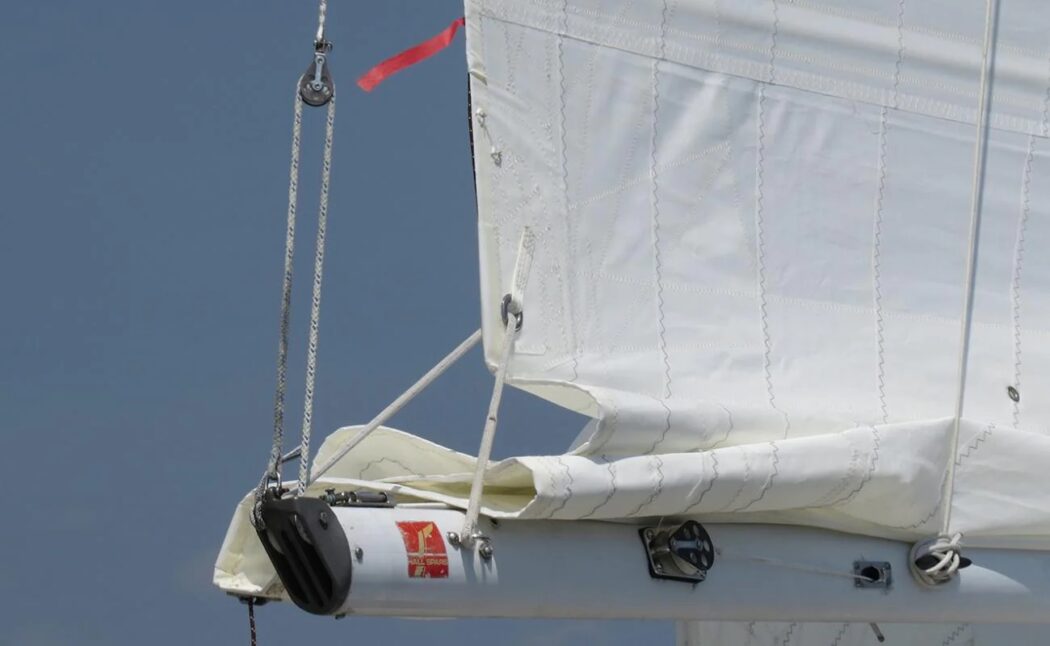The Art of Reefing a Sail: Essential Sailing Techniques
Immerse in the euphoria of sailing and feel the intimate bond with nature that this timeless adventure offers. Regardless of whether your sailing log is pages long or this is your maiden voyage, understanding the art of reefing a sail is a crucial skill set in your sailing proficiency.
The technique of reefing significantly curtails the sail area during strong wind conditions, empowering the sailor with enhanced control and safe manoeuvrability of the vessel. It also plays a vital role in circumventing potential damages to the sail and rigging apparatus.
Reefing a sail is among the fundamental skills necessary for safe sailing. It’s so essential that it frequently forms the cornerstone of onboard training programs for sailors. Never should one venture into the waters without a comprehensive understanding and proficiency in this technique – it stands fundamental to sailing!
The ability to execute reefing efficiently and promptly, especially under pressing conditions, is so significant that sailors often indulge in drills around the harbour. This rehearsal ensures readiness to reef swiftly and effectively. With adequate knowledge and practice, reefing a sail becomes a simple task – a technique that enhances comfort during sailing and, more importantly, ensures safety.
In this comprehensive guide to reefing a sail, we aim to provide you with a thorough understanding of every facet of reefing. From identifying the right conditions to reef to exploring the varied reefing techniques and knowing the required equipment, we have you covered.
So, gear up in your sailing attire, and let’s embark on an enlightening journey through the realm of reefing a sail!
Understanding the Art of Reefing a Sail
Reefing is a pivotal sailing manoeuvre that entails modifying the sail’s expanse to maintain control during high wind conditions. This practice involves adjusting, folding or rolling a portion of the sail and securing it to the boom or mast, thereby minimizing the sail’s surface exposed to the force of the wind.
By reducing the wind’s impact on the boat, stability and controllability are significantly improved. This vital technique is one of the first lessons in any sailing course and is indispensable for any sailor. The knowledge of reefing can indeed be the thin line between a safe, enjoyable sail and a potentially risky one.
Let’s delve deeper into the nuances of reefing and arm you with valuable tips and strategies for successful execution of this manoeuvre.
When and Why to Reef?
The primary purpose of reefing is to make the vessel manageable and safer during high wind conditions. However, the question often arises – when is the right time to reef? Here are some indicators that suggest it might be time to consider reefing your sail:
- The vessel is leaning excessively, making movement and normal operations difficult;
- The helm shows a significant amount of weather helm (tendency to turn into the wind);
- Control over the vessel becomes challenging.
Techniques of Reefing
There are different techniques for reefing a sail, each having its own advantages and applications. Below we discuss two of the most widely used methods:
- Slab or Jiffy Reefing: This is the most common method, best suited for cruising. The process involves lowering the mainsail slightly and securing the reef points around the boom;
- In-mast or In-boom Furling: This method involves rolling the sail inside the mast or the boom. While it adds complexity and cost to the rigging system, it provides ease and convenience, especially for short-handed crews.
Equipment for Reefing
Proper equipment can simplify the process of reefing, making it more efficient and safe. Some essential gear includes:
- Reefing lines: Used to secure the sail after it’s been reduced;
- Reefing hooks: They secure the luff of the sail during the reefing process.
Decoding the Ideal Timing for Reefing a Sail
Reefing a sail, an integral aspect of sailing, aids in the optimal management of sail’s surface area during gusty winds. Identifying the perfect time for this technique somewhat hinges on several factors like wind intensity, the boat and sail structure, and the proficiency or comfort of the crew onboard.
Typically, sailors decide to start reefing the sails when wind speeds reach approximately 18 knots. However, this could vary depending on type and structural characteristics of the vessel. For compact, lightweight boats, the necessity to reef might arise earlier. In contrast, larger, more robust boats may tolerate more intense winds before reefing becomes crucial.
Even so, precautionary measures are advised, and it’s often safer to reef earlier regardless of the boat’s ability to withstand stronger winds. Anticipating changing weather conditions and being prepared can make a significant difference in the sailing experience.
A Comprehensive Guide to Reefing a Sail
The capacity to skillfully reef a sail while sailing is an indispensable aspect of a sailor’s expertise. Variations in the reefing system can occur based on the boat and sail type. Hence, it’s imperative to acquaint yourself with the sailboat’s specific reefing mechanism before venturing into the water.
Although the process varies, commonalities exist in the core fundamentals of reefing. Below, we provide a comprehensive walk-through of the basics of reefing both the headsail and mainsail – two prominent types of sails on a boat.
Reefing the Headsail
Notably, the majority of modern sailing vessels employ a roller-reefing system for the headsail. This system provides the convenience of reducing the sail area from the cockpit, making reefing more manageable and safer. Here are the general steps involved:
- Release the headsail sheet to slacken the sail;
- Operate the furling line, which in turn, rolls the sail around the forestay, reducing its size;
- Once the desired sail area is achieved, fasten the furling line securely;
- Tighten the headsail sheet to regain appropriate sail shape and tension.
Reefing the Mainsail
The mainsail can employ different reefing systems, including slab reefing or jiffy reefing, and roller or in-mast reefing. Here’s a general outline of the slab or jiffy reefing process:
- To begin with, ease out the mainsail halyard to lower the sail partially;
- Next, attach the reef point on the luff side of the sail to a hook at the gooseneck (where the boom connects to the mast) or pull the reefing line through the reef point to pull the luff down to the boom;
- After securing the luff, move to the leech and do the same;
- Lastly, tighten up the halyard to restore tension to the sail.

Mastering the Technique of Reefing a Headsail
Reefing a headsail proves to be simpler when compared to reefing a mainsail. It primarily involves reducing the surface area of the sail, thereby minimizing the impact of wind on the boat. Here’s a step-by-step guide on how to successfully reef a headsail:
Step 1: Determine the Degree of Reefing Required
The extent to which the headsail needs to be reefed depends on multiple factors, including the wind speed, sea conditions, and the boat’s stability. With a roller furling headsail, the process is quite straightforward – simplifying to the task of rolling it up to the desired extent. For a hank-on headsail, however, you will have to detach the hanks up to the necessary reefing points.
Step 2: Positioning the Boat
Aim to position the boat facing the wind. This maneuver reduces the pressure on the sail, making it safer and more manageable to reef. The headsail should be fully luffing – or fluttering in the wind – before initiating the reefing process.
Step 3: Proceed with Furling or Detaching the Hanks
Initiate the process of furling the sail or unhitching the hanks as required – depending on the type of headsail your sailboat sports. For a roller furling headsail, use the furling line to roll up the sail up to the determined reefing point. For hank-on sails, proceed with removing the necessary hanks and then tie the sheets back to the reefing points.
Step 4: Adjust the Sails
After successfully reefing the sail, it’s crucial to trim the sheets at the correct angle. This adjustment, coupled with the tweaking of the jib lead, ensures the optimal functioning of the reefed sail.
Step 5: Resume Sailing
Finally, return to your original sailing course. Make any necessary adjustments to the sail trim to maximize the sailing efficiency with the newly reefed headsail.
Which Sail Do You Reef First?
In the realm of sailing, a prevalent query arises: Which sail ought one to reef initially? The common counsel is to first constrain the mainsail, followed by the jib sail. This recommendation stems from the mainsail’s relative enormity and its more challenging management compared to the headsail. Moreover, in vigorous winds, an unrestrained mainsail can significantly sway the vessel’s equilibrium and maneuverability.
Reefing the mainsail is often a more arduous task, as it typically necessitates ascending towards the boom, an action not particularly favored in tumultuous seas.
Nonetheless, the sequence of reefing can fluctuate based on several elements, including the vessel’s architectural design, the arrangement of the sails, and the prevailing sailing conditions.
Take, for instance, our genoa sail, which is astoundingly vast. Under certain circumstances, particularly when the wind’s intensification is not anticipated and the weather is capricious, we opt to reef this sail first. It’s considerably more straightforward to introduce and remove reefs on a furling headsail.

What If The Sails Are Already Fully Reefed?
Should your vessel remain excessively propelled despite maximal sail reduction, inaction is not a prudent course! Persisting in navigating with an excessively dynamic rig can precipitate a plethora of adverse occurrences, not least of which are the potential rending of sails (a costly misfortune to rectify) and the peril of dismasting.
In situations where the gale’s ferocity renders your current sail configuration untenable, the judicious action is to lower these sails and hoist a tempest sail. This diminutive, stoutly constructed fore-sail, designed for the harshest of conditions, should be affixed in anticipation of such trials.
It is imperative, however, that this is not your inaugural endeavor with the storm sail. Familiarity with its operation, ensuring its ready availability, and proficiency in its deployment are essential.
Should overpowering conditions persist, or in the absence of a fore-sail, several strategies may be employed, contingent upon your vessel’s design, your geographical positioning, and your sailing acumen.
- Navigating solely with the vessel’s bare poles is a viable option for some crafts, as they can maintain a semblance of progress in sufficiently potent winds. The decision to employ this tactic is influenced by the vessel’s design, the wind’s character, and the state of the sea;
- Heaving to is often a wise choice in tempestuous conditions. This technique allows the boat to gracefully surmount waves while progressing minimally, affording you the opportunity to retreat below deck for a respite, perhaps to brew a calming beverage, as the storm abates;
- Utilizing the motor, particularly in enclosed bays or when in proximity to land, may often be the most advisable action. Sailing a vessel without its sails can occasionally be the optimal strategy.
Conclusion
It’s crucial to understand that headsail reefing is not necessary for all sailing conditions. The specific steps to execute this process may vary based on the boat’s make and the sailing equipment onboard. Notably, furling headsails offer the flexibility of continuous reefing as per requirement. However, a potential downside could be the slight distortion in the sail’s shape due to extensive reefing, particularly with older sails. Nonetheless, during strong winds requiring reefing, the priority often shifts from achieving maximum performance to ensuring safety. With the correct knowledge and practice, headsail reefing becomes an easier, safer maneuver, enhancing the overall sailing experience.

Leave a Reply